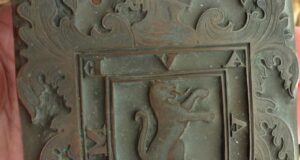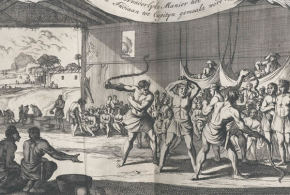Written by Randy Shaw Several years ago General Jose Ramon Pizarro who was many times over the great grandson of the Spanish Chronicler and Conquistador Pedro Pizarro passed away in Lima Peru his widow contacted a mutual friend to discuss an item that had descended down through the family of Pedro Pizarro. So on my next trip to Lima my ...
Read More »Author Archives: Marco Ramerini
The Dutch Fort of Tangalle, Sri Lanka
Written by Marco Ramerini. Photos by Dirk Holtschlag. Tangalle is a small coastal town located a few kilometers east of the city of Matara, in the extreme south of the island of Ceylon. At the time of the Dutch occupation of Ceylon, Tangalle, thanks to its natural harbor, was used by them as an important anchorage. Here, around 1775, the Dutch ...
Read More »St Thomas Fort, Tangasseri or Thangassery, Kerala, India
Written by Marco Ramerini. Photos by Prof. Rahul Basu. Tangasseri or Thangassery / Kollam is a city located along the coast of the ancient Malabar, in the Indian state of Kerala in southern India. The Portuguese were the first Europeans to arrive in this port of Malabar, they landed there in 1502. In the following years Tangasseri or Thangassery / Kollam that the Portuguese called ...
Read More »The Catholic mission in Bengal prior to the nineteenth century
Written by Prof. Stefan Halikowski Smith, Dept. of History, Swansea University. The Bengal mission was one of the most Christian successful mission-fields in the Orient in early modern times, despite relatively small numbers of active missionaries. However, the mission, despite its successes in ‘harvesting souls’, encountered bitter political vituperation between the two orders active here, the Augustinians and Jesuits, who ...
Read More »The Portuguese fort of Santiago, Cape Verde
Photos by João Sarmento. Written by Marco Ramerini. The Cidade Velha (Old Town) of the island of Santiago in Cape Verde islands is located 15 kilometers west of the city of Praia, along the Santiago island coast. It constitutes the first city built by Europeans in the tropics and the first capital of the Cape Verde archipelago. The settlement was originally named ...
Read More »The Portuguese fort in São Tomé
Photos by João Sarmento. Written by Marco Ramerini. The Portuguese Fort São Sebastião, São Tomé, São Tomé e Príncipe. The fort was built in 1575. The fort was occupied by the Dutch on 16 Oct. 1641. The Portuguese recaptured the fort on 15 December 1644. The Fort São Sebastião is square-shaped with bastions at each corner and now houses the São Tomé and Príncipe National Museum.
Read More »The Portuguese forts in Morocco
Photos by João Sarmento. Written by Marco Ramerini. Some pictures of what remains of forts built by the Portuguese in Morocco in the 15th and 16th century. Here are presented photos of Azamor (Azemmour), Safim (Safi) and Mazagão (El Jadida) taken by João Sarmento. The fort of Azamor (Azemmour) was under Portuguese control between 3 September 1513 and October 1541. The fort of Safim (Safi) called by ...
Read More »Adriaan van Berkel’s Travels in Guyana
Adriaan van Berkel’s Travels in Guyana – The Voyages of Adriaan van Berkel to Guiana Reissue of the original Dutch 1695 publication with a new English translation, and annotated and introduced by Lodewijk Hulsman, Martijn van den Bel and Lodewijk Wagenaar The Dutch presence in the Guianas and the Amazon River goes back to the end of the 16th century. ...
Read More »Sri Lanka Burgher Family Genealogy: Andree/Abernethy
Written by Phil Abernethy. Enid Ursula Andree was born on the 28 Oct 1928 in KL Malaysia my father Fredrick Alexandra Abernethy (Freddy) die on the 23 May 1979 in Perth WA, they had 2 Children, myself – Philip Andrew Abernethy born 23 June 1960 in KL Malaysia and Anna Agnes Abernethy born 22 Jul 1948 in KL Malaysia, married ...
Read More »The Role of the Portuguese Language in Lusophone Asia
Written by Dietrich Köster Portuguese India/Estado da Índia Portuguesa – Goa, Daman/Damão and Diu Until the invasion of Nehru’s troops in December 1961 Portuguese was the official language, while after the annexation English received this status. The local languages Konkani in Goa and Gujarati in Damão and Diu only play a minor role in public life. Even during the Portuguese ...
Read More »Political Development of the former German Colonies since 1920
Written by Dietrich Köster COLONIES IN AFRICA GERMAN EAST AFRICA, takeover in 1884/85 Tanganyika Territory 1920 to the United Kingdom – 1961 Independent State of Tanganyika/1962 Republic of Tanganyika – April 1964 part of the United Republic of Tanganyika and Zanzibar/ November 1964 United Republic of Tanzania Ruanda-Urundi 1920 to Belgium – 1962 Republic of Rwanda (northern part) and 1962 ...
Read More »The Forts of the Spice Islands of Indonesia, Today
Written by Simon Pratt Forts of the Banda Islands The Banda Islands, reached via Ambon, contain some of the most historic and evocative forts of the old Dutch East Indies. Most impressive is Dutch-built Fort Belgica (constructed 1611) towering over the tiny township of Bandaneira. Following refurbishment in the 1990’s it remains the best preserved of all forts scattered across ...
Read More »Bahrain: Portuguese Fort of Qal’ at Arad
Written by Marco Ramerini. Photos by João Sarmento. English text revision by Dietrich Köster. The Portuguese Fort of Qal’ at Arad, Bahrain. The fort of Arad is located on the island of Muharraq – the northernmost island of the archipelago of Bahrain – the fort rises in front of the beach in a cove along the southern coast of the ...
Read More »Bahrain: Portuguese Fort of Halat Bu Maher
Written by Marco Ramerini The fort of Halat Bu Maher (also know as Qal’at Abu Mahir) is located on Muharraq island – the northernmost island of the archipelago – and was strategically situated to control both the straits between Bahrain and Muharraq, and the bay between Muharraq Town and Arad Fort. In 1630s. the Portuguese maps (“Livro das Plantas de ...
Read More »Bahrain: Portuguese Fort of Qala’at al-Bahrain (Bahrain Fort)
Written by Marco Ramerini. Photos by João Sarmento. English text revision by Dietrich Köster. The Portuguese Fort of Qala’at al-Bahrain (Bahrain Fort), Bahrain. Remains of Qal’ At Al-Bahrain (16th century) or Portuguese Fort. The fort consists of three huge strongholds and the remnants of two towers in the middle and full walls linking the three strongholds together. It is surrounded ...
Read More »Maramuca: Portuguese Settlement, Market (Feira) in Zimbabwe
Written by Chris Dunbar. All pictures are copyright by Chris Dunbar. Maramuca, 2010: The trip to Maramuca was via the town of Chegutu and then another 30 odd kilometres on an old strip road to the gold mining town of Chakari. From Chakari we had to travel on a dirt road which later turned into a dirt track. The location ...
Read More »Great Zimbabwe: a ruined city in the southeastern hills of Zimbabwe
Written by Marco Ramerini. Photos copyright by Chris Dunbar. Great Zimbabwe was the capital of the Kingdom of Zimbabwe where was the royal palace and the seat of the political power. The city was surrounded by massive walls that reach 5 meters in height which were constructed without mortar. The area where is Great Zimbabwe was occupied from the fourth century ...
Read More »Portuguese Forts, Markets (Feira) and Settlements in Zimbabwe
Written by Chris Dunbar The following is a list of sites that were investigated by the Rhodesian / Zimbabwean Government, no suspected Portuguese sites have been restored (unfortunately) and no more have been added since the first cataloguing was done in the early 1970’s. A number of the historical trading centres and forts have still not been located and further ...
Read More »Massapa: Portuguese Settlement, Market (Feira) and Fort in Zimbabwe
Written by Chris Dunbar. All pictures are copyright by Chris Dunbar. Massapa was described in 1573 as being close to the wooded mountain Fura (Mt Darwin) had a Dominican Church dedicated to the Lady of the Rosary and was deserted in 1693 when the Rozvi went on the rampage that ended the Portuguese control on the whole Northern Zimbabwe plateau ...
Read More »Piringani: Portuguese Settlement, Market (Feira) in Zimbabwe
Written by Chris Dunbar. All pictures are copyright by Chris Dunbar. So to Piringani (Piringani: 16°59′ 48.63″S 30°11′ 27.97″E), in the north west of Zimbabwe, in the farm lands of Doma, I went. Rumour had it that there was a Lemon forest and that it was marked and known by the local farmers and the Department of National Monuments. I ...
Read More » Colonial Voyage The website dedicated to the Colonial History
Colonial Voyage The website dedicated to the Colonial History


















